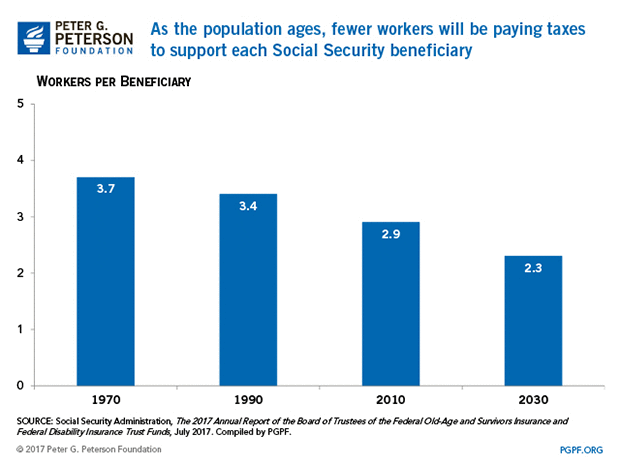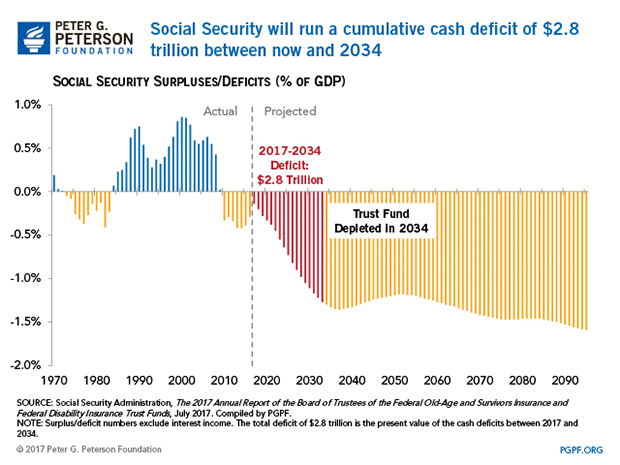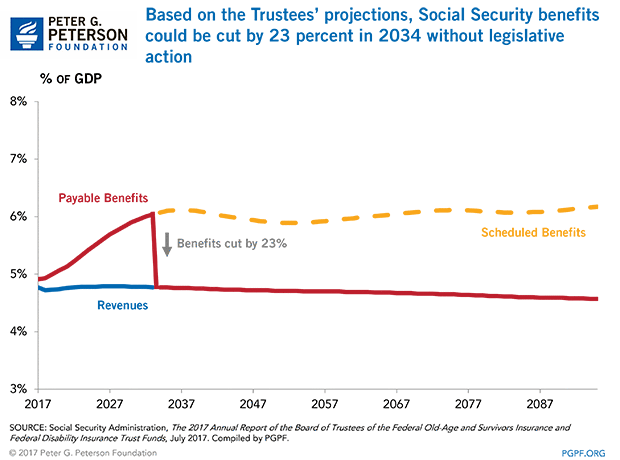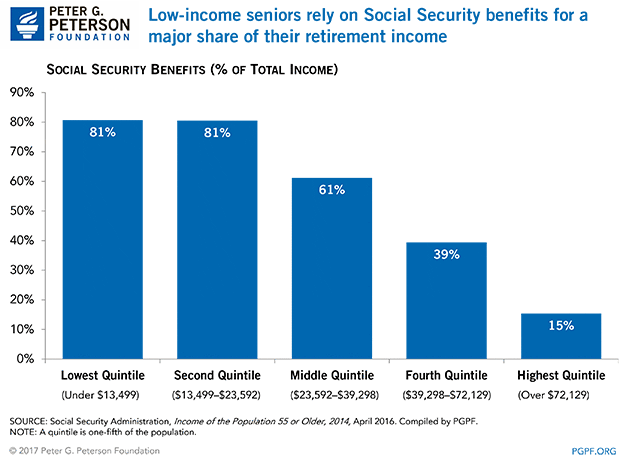Today, the Social Security Trustees warned that the program faces major financial challenges, which threaten its sustainability and ability to provide essential benefits to millions of Americans.
According to the Trustees’ annual report, Social Security’s finances are facing growing pressure due to the aging of the population. As the large baby boom generation enters retirement and Americans continue to enjoy longer lifespans, more and more individuals will collect benefits from the system and for longer periods, while relatively fewer workers will contribute taxes to support it.
Social Security’s financial imbalance is the result of simple math. Since 2010, the Social Security program has been spending more than it has been taking in, and the Trustees project that these deficits will grow sharply in coming years. According to the report, the program’s trust funds will be exhausted in just 17 years, which will put millions of beneficiaries at risk of large benefit cuts.
Specifically, the Trustees find that:
- The combined Social Security trust funds are projected to be fully depleted by 2034 — just 17 years from now.
- Without legislative action, all Social Security beneficiaries — 87 million in total — could face across-the-board benefit cuts of 23 percent in 2034.
- The Social Security Disability Insurance Trust Fund is estimated to be depleted even sooner — in 2028.
- Without legislative action, approximately 11 million disabled people and their families could face across-the-board benefit cuts of 7 percent in 2028.
Social Security is critical to the retirement security of millions of Americans — and particularly low-income and disabled Americans. Lawmakers should work together to address these predictable imbalances to make the program sustainable for the long term. The good news is that many solutions exist — as the Trustees emphasize in their report: "With informed discussion, creative thinking, and timely legislative action, Social Security can continue to protect future generations."
What Is Social Security?
Social Security is the largest single federal program. It accounts for approximately one quarter of all federal spending. Almost every American worker pays a dedicated payroll tax that entitles them (as well as their spouses and survivors) to benefits when they retire or become disabled. Payroll taxes and other revenues are credited to two trust funds: the Old Age and Survivors Insurance Fund (OASI) and the Disability Insurance Fund (DI). OASI provides benefits for retired workers and their families, as well as survivors of deceased workers, and DI provides benefits for disabled workers and their families. Of the approximately 62 million people who currently receive Social Security benefits, approximately 83 percent receive payments through OASI and 17 percent receive DI benefits.
Demographic Trends Are Putting Financial Pressure on Social Security
The aging of the population creates serious financial challenges for Social Security. As baby boomers retire and life expectancy continues to increase, the number of Social Security beneficiaries is projected to climb sharply over the next several decades. By 2034, the total number of beneficiaries is projected to reach 87 million — 41 percent more than the number in 2017. Over the same period, the ratio of workers paying taxes to support each Social Security beneficiary will decline significantly from 3:1 to 2:1. In 1970, this ratio was nearly 4:1.


This very predictable, growing mismatch between the number of people paying into Social Security and the number receiving benefits will cause Social Security spending to increase significantly more than revenues. The Trustees project that OASDI outlays will grow from 4.9 percent of GDP in 2017 to 6.1 percent by 2034 — a 24 percent increase. By contrast, the system’s revenues will remain constant at 4.8 percent of GDP.
The Trust Funds Will Be Exhausted in 17 Years
These budgetary imbalances will translate into growing annual cash deficits that will deplete the system’s trust funds.
In 2017, Social Security’s cash deficit (excluding interest) is projected to be $27 billion. Between now and 2034, the annual cash deficits are projected to total $2.8 trillion. During this period, the trust fund balances will be exhausted. However, it is important to understand that the trust funds only contain Treasury “IOUs” — the funds taken in by Social Security in past years were already spent on other programs. Therefore, even though the trust funds technically have a balance for the next 17 years, the Treasury will still have to borrow funds from the public to cover the program’s cash deficits.

Absent legislative action, the Trustees project that the trust funds will be fully exhausted in 2034. At that point, Social Security will no longer be able to pay full benefits, and all 88 million beneficiaries — not only new retirees, but existing retirees — could face a 23 percent cut in benefits. For a retiree with average pre-retirement earnings, that amount is approximately $5,969 annually in today’s dollars. A reduction in benefits of this magnitude would impose huge burdens on low-income seniors because Social Security is a primary source of their income. Social Security provides more than 80 percent of the income of seniors in the bottom 40 percent of the income distribution (those with $23,592 or less in total income).


The Disability Trust Fund Will Be Depleted in 2028
The financial outlook of the Disability Insurance (DI) Trust Fund is even more troubling. Although legislation enacted at the end of 2015 kept the DI Trust Fund from being exhausted in 2016, the reform only delayed the date of exhaustion of the DI trust fund to 2028. And because the reform achieved that goal by simply transferring payroll tax revenues from the OASI program to the DI program, it worsened the condition of OASI and did nothing to improve the financial condition of the combined program.
The Trustees urge that "legislative action is needed soon to address the DI program’s financial imbalance." If no additional legislation is enacted before 2028, benefits for 11 million disabled Americans and their families could be cut by 7 percent.
Solutions
The good news is that many policy solutions are available to address this predictable challenge and improve the financial outlook of Social Security. The Congressional Budget Office has published a report containing thirty options for improving the long-term stability of the program. Examples of reforms include: reducing annual cost of living adjustments, increasing payroll taxes, lifting the income cap on payroll taxes, reducing initial benefits, and raising the retirement age. The Bipartisan Policy Center also published a major report outlining options for strengthening both Social Security and overall retirement security.
Importantly, if policymakers act sooner rather than later, they will have more and better options, which can be gradually implemented to reduce the impact on current and future beneficiaries. Conversely, every year of delay and inaction limits options and makes reform more difficult, which will require larger benefit cuts, higher taxes, or both.
For their basic financial planning, the American people need to know well in advance what benefits they will receive in retirement.
The math is simple, and the consequences of inaction are clear. Policymakers should work together to stabilize and strengthen this important program for generations to come.
Photo by Redgoldwing/Getty Images
Further Reading
Budget Basics: Unemployment Insurance Explained
The Unemployment Insurance program is a key counter-cyclical tool to help stabilize the economy and speed recovery during downturns or crises.
Can We Raise the Retirement Age and Protect Vulnerable Workers?
Raising the retirement age could harm workers who would be unable to delay retirement due to physically demanding occupations, disability, or job loss.
What Is SNAP? An Overview of the Largest Federal Anti-Hunger Program
SNAP has a positive effect on poverty and food insecurity, with a relatively small effect on the federal budget.


